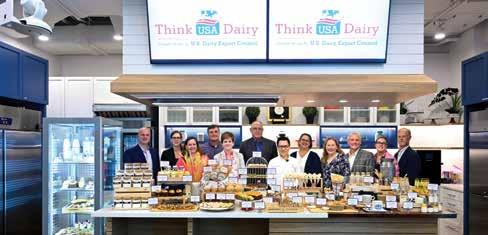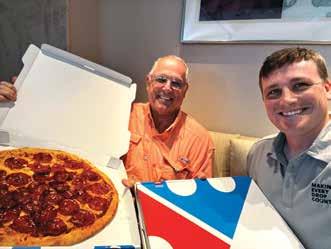
3 minute read
MEET Alex Peterson
A Midwest Dairy farmer is getting involved and acting on his passion for exports. Alex Peterson, a dairy farmer from Trenton, Missouri, is no stranger to leadership roles and is eager to leave his mark on the industry. He has had the privilege of serving two years as the National Dairy Board (NDB) Chair, where his primary role was to ensure the other 36 members, who represented every dairy farmer in the country, had the information, insight, and foresight they needed to best direct dairy checkoff funds. His goal was for all participants to have a solid understanding of the massive territory covered by checkoff and provide a deeper dive into areas of focus. These areas included the reputation of dairy with today’s consumers, product innovation to stay fresh and relevant, breaking down barriers that hinder U.S. dairy from reaching those that desire it globally and much more.

Advertisement
Peterson answered some questions about exports and shared his insight on the exciting opportunities ahead for the dairy industry.
1. How did your passion for exports begin?
Like any good farmer, I have developed the habit of staring across the fence to see what the neighbors are up to, see if they need help, or look for good ideas I can imitate. That curiosity only understanding foreign dairy technical regulations and, at times, taking action when new regulations threaten to hinder trade, as well as providing dairy exporters insight and analysis on global markets to ensure U.S. dairy can maximize opportunities internationally.
As we look ahead and continue into 2023, exports power the industry’s growth, as five out of the last six years, exports have grown more than domestic consumption. However, checkoff realizes that 2023 will be a challenging year. Lackluster economic growth and high inflation rates worldwide will challenge global dairy demand. Additionally, with improved milk production out of the European expanded as the world has gotten smaller and smaller. When I was assigned to the exports committee at my first DMI meeting in 2018, I was able to add another layer to my appreciation of the complexity of international affairs. People worldwide need nourishment, and that’s what dairy can offer. I feel we are getting better at connecting those two dots in a mutually beneficial way despite many natural and man-made headwinds. A few years ago, I became the Vice Chair of the United States Dairy Export Council (USDEC). My role there is to be a farmer voice in the organization as it works to make it as easy as possible for U.S. dairy companies to develop and capture value from consumers worldwide.
Union and New Zealand, U.S. suppliers face increased competition in international markets. Through the first two months of 2023, U.S. exports were still running ahead of 2022 levels in volume and value, but today, growth has slowed. In February, year-over-year U.S. dairy export value fell for the first time in over two years due to lower international commodity prices and a higher portion of the U.S. export portfolio comprised of lower-value products like lactose. Nevertheless, USDEC is still hopeful that U.S. dairy exports on a milk solid equivalent basis will grow slightly in 2023.
Checkoff-supported USDEC programs have been instrumental as a catalyst to
2. How can grassroots farmers support U.S. exports from the farm?
Dairy checkoff dollars partially fund USDEC and its efforts, so all grassroots farmers are due credit for the success of our dairy sales internationally! But, above and beyond that, farmers can keep two things in mind: drive demand for U.S. dairy products, expand market penetration and raise market share. As you can see, exports are a top priority for checkoff, but equally important are the 82 percent of domestic sales that happen right here in the U.S., as the dairy industry needs both exports and domestic sales to stay thriving.

• Continue to improve at what you do. Consumers worldwide appreciate our high quality, unmatched reliability, and continuous improvement in how sustainably we produce dairy products.
• When you talk to your elected representatives in Washington, let them know how important access to markets internationally is to our industry.
3. You recently visited Singapore and Japan; what did you learn?
On the USDEC trade mission to Singapore/Japan, I learned about a region where three-quarters of a billion people are looking to add more protein and nutrition to their diet. They know dairy protein and nutrition are a good standard and have very high trust in US products, especially agricultural. In light of that insight, it was encouraging to see the great work of our USDEC teams on the ground and the resources we have given them to support U.S. Dairy exports to the region.
4. How do trips like that positively affect the U.S. dairy?
In the grand scheme of things, we are the new kid on the dairy export block.
These trips assure buyers of our commitment to their market, help them feel assured that we are authentic in our pledge to continue improving our high standards, and meet dairy farmers to build a personal connection that helps when the inevitable geopolitical tensions disrupt. These trips are also big moral boosters for our staff working in these markets and the many different U.S. government officials we meet with stationed in the region. Getting people excited about dairy also involves interacting with local social media influencers and training chefs on how to use U.S. dairy products in their work. Most importantly, it helps us ensure that USDEC is providing the services our members need to succeed.

